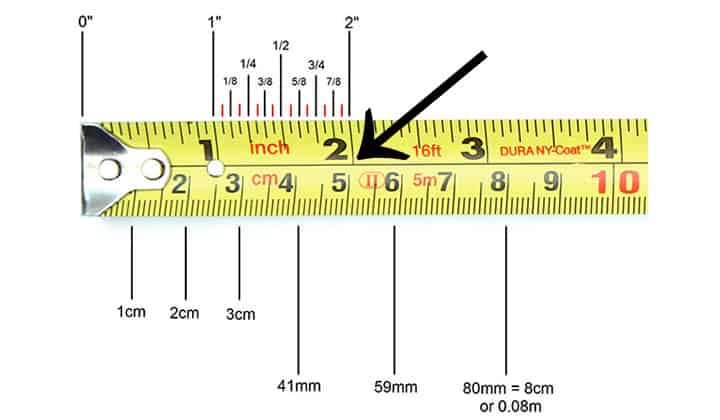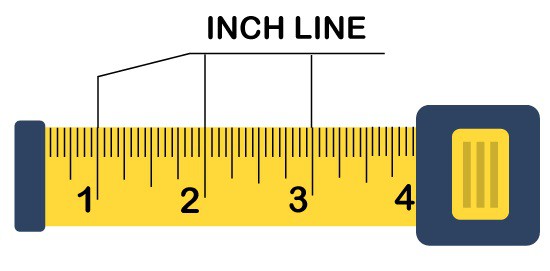I love creating free content full of tips for my readers, you. I don't accept paid sponsorships, my opinion is my own, but if you find my recommendations helpful and you end up buying something you like through one of my links, I could earn a commission at no extra cost to you. Learn more
Have you ever been in a scenario where you needed to take measurements of material but you didn’t know how to do so? This happens on a fairly regular basis, and I believe that everyone encounters it at least once in their lives. This measuring procedure appears to be somewhat difficult at first, but after you’ve learned it, you’ll be able to determine any material measurement with the snap of your fingers.

In this post we'll cover:
What Is A Measuring Tape
A measuring tape is a long, flexible, thin strip of plastic, fabric, or metal that is marked with measurement units (such as inches, centimeters, or meters). It is commonly used to determine the size or distance of anything. Measurement tape is made of a bunch of different pieces including case length, spring and stop, blade/tape, hook, hook slot, thumb lock, and belt clip. This tool can be used to measure any substance in different measurement units such as centimeters, meters, or inches. And I’m going to show you how to do it all on your own.Read Your Measurement Tape-In Meters
Reading measuring tape is a little bit confusing because of the lines, borders, and numbers inscribed on it. You may wonder what exactly those lines and numbers mean! Don’t be afraid and believe me it’s not as difficult as it appears. It may look difficult at first, but once you get the concept, you’ll be able to record any measurement in a short period. To do this, you must follow some technique that I will break down into multiple phases so that you may grasp it quickly.- Look for the row with metric measurements.
- Determine the centimeters from the ruler.
- Determine the millimeters from the ruler.
- Identify the meters from the ruler.
- Measure anything and make a note of it.
Look For The Row With Metric Measurements
There are two types of measuring systems in a measurement scale including imperial measurements and metric measurements. If you observe closely you will notice that the top row of numerals are imperial readings and the bottom row are metric readings. If you wish to measure something in meters you have to use the bottom row which is metric readings. You can also identify metric readings by looking at the ruler’s label, which will be engraved in “cm” or “meter” / “m”.Find Meters From Measurement Scale
Meters are the largest labels in the metric measurement system of a measuring tape. When we need to measure anything large, we usually utilize the meter unit. If you look closely, every 100 centimeter on a measuring scale has a longer line, which is referred to as a meter. 100 centimeters is equal to one meter.Find Centimeters From Measurement Scale
Centimeters are the second-largest marking in the metric row of a measuring tape. If you look attentively, you’ll see a somewhat longer line between the millimeter’s markings. These slightly longer markings are known as centimeters. Centimeters are longer than millimeters. For example, between the numbers “4” and “5”, there is a long line.Find Millimeters From Measurement Scale
We would learn about millimeters in this phase. Millimeters are the lowest indicators or markings in the metric measuring system. It is the subdivision of meters and centimeters. For example, 1 centimeter is made of 10 millimeters. Determining millimeters on the scale is a little bit tricky because they are not labeled. But it’s not that tough either; if you look closely, you’ll notice 9 shorter lines between “1” and “2,” which represent millimeters.Measure Any Object And Make A Note Of It
You now understand all there is to know about a measuring scale, including the meter, centimeters, and millimeters, which are all necessary for measuring any object. To start measuring, begin at the left end of the measurement ruler, which may be labeled with “0”. With the tape, go through the other end of what you’re measuring and record it. The measurement in meters of your object can be found by following the straight line from 0 to the last end.Measurement Conversion
Sometimes you may need to convert measurements from centimeters to meters or millimeters to meters. This is known as measurement conversion. Suppose you have a measurement in centimeters but want to convert it to a miter in this case you will require measurement conversion.
From Centimeters To Meters
One meter is made up of 100 centimeters. If you wish to convert a centimeter value to a meter, divide the centimeter value by 100. For example, 8.5 is a centimeter value, to convert it into meters, divide 8.5 by 100 (8.5c/100=0.085 m) and the value will be 0.085 meters.From Millimeters To Meters
1 meter equals 1000 millimeters. You have to divide a millimeter number by 1000 to convert it to a miter. For example, 8.5 is a millimeter value, to convert it into a miter divide 8.5 by 1000 (8.5c/1000=0.0085 m) and the value will be 0.0085 miters.Conclusion
Knowing how to measure anything in meters is a fundamental skill. You should have a firm grasp of it. It is an essential skill that you need in daily life. Despite this, we are afraid of it, since it appears to be difficult for us. Yet measurements aren’t as complicated as you might think. All you need is a solid understanding of the scale’s components and a knowledge of the math underlying it. I’ve included all you need to know about measuring anything on a meter scale in this post. Now you can measure diameter, length, width, distance, and anything you want. If you read this post, I believe the subject of how to read a measuring tape in meters will no longer concern you.I'm Joost Nusselder, the founder of Tools Doctor, content marketer, and dad. I love trying out new equipment, and together with my team I've been creating in-depth blog articles since 2016 to help loyal readers with tools & crafting tips.
